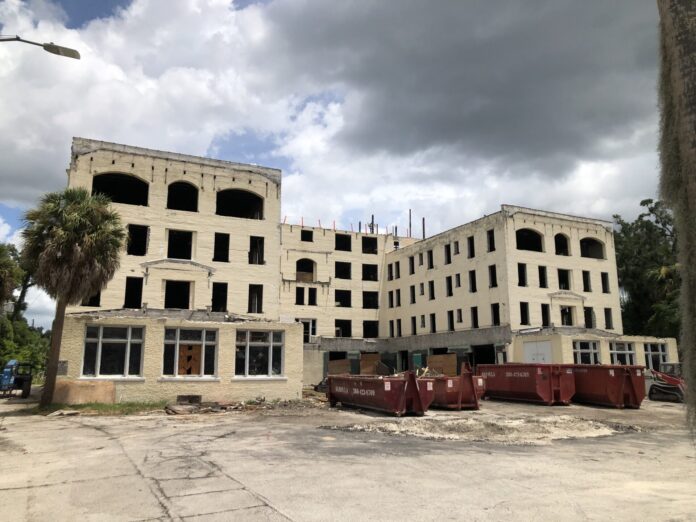City finds structural concerns; owner says ‘not a deal-killer’
The inside of the dilapidated Hotel Putnam has been cleared out, worrisome structures have been demolished, and the next phase of the building’s rehabilitation is on its way.
But first, the owner’s engineer must submit a plan to fix damage to the building’s interior. Currently, the building has been deemed “unsafe” by the City of DeLand, and no work can proceed without a rehabilitation plan.
On Aug. 25, DeLand Building Official Joe Levrault went to take a look at the Putnam, and what he found worried him.
“On the top floor, it looks as though a very heavy load was placed on the roof, causing the metal ceiling joists to deflect significantly, deeming that area unsafe,” he wrote in an email to Putnam construction superintendent Peter King. “Giving what I saw structurally, added to what I asked the structural engineer to address in his last visit, I have no choice but to post the structure as ‘Unsafe.’”
The owners, Axia Partners, were aware of a lot of the damages to the Putnam’s interior, Managing Partner Jeremy Long told The Beacon.
“I don’t think there was any kind of qualms from us that we thought this building was beautiful, that we were going to move in the next day,” he said. “The way this works, we have to get all of the structural changes complete while it’s going through permitting.”

FLOOR SHIFT — On one of the historic building’s upper levels, a beam broke away from its bearing, causing the floor to deflect around 5 inches, engineers said. The exterior wall also shows a large crack. Structural engineers recommended that the beam be reinforced.
Long insisted there were no plans to raze the building.
“There’s nothing in there that was found that’s like ‘Game over.’ There’s some superficial stuff here, like when we took off the canopies, there’s maybe a crack up there we didn’t see,” he said, “but nothing huge.”
Some of the more recently revealed damages to the inside were found during demolition.
“While they were doing interior demos, it’s taking some of the stucco off of the inside of the brick walls,” Levrault told The Beacon. “They encountered some areas that were structurally unsound.”
Those included columns that had sunk into the ground and support beams that bent as the building settled. Other damage happened when front-end loaders were used inside to remove concrete and wood flooring.
“Some of the stuff was exposed, and just the wear from the small front-end loaders they had inside the building, moving around some soil that’s at grade-level,” Levrault said. “All that vibration could have caused some of that happening.”
One contributing factor could have to do with the building’s age. Not only is the concrete foundation the Putnam sits on not as thick as that below many modern buildings of its size, but the masonry is believed to be sand brick. Sand brick is a building material utilized around Downtown DeLand in the 19th and 20th centuries. Sand-brick buildings are very fire-resistant, but prone to damage due to wear-and-tear and vibration from traffic and construction.

HEAVY LOAD? — Bent ceiling joists inside the Hotel Putnam seem to indicate that a “very heavy load” was placed on the roof, City of DeLand Building Official Joe Levrault told those working on the renovation project.
Levrault didn’t think the building was made of sand brick, but local historian Sidney Johnston argued otherwise. Photos Johnston has taken of the Putnam sure look like sand brick, he said.
“Once a certified lab tests the brick-wall material on the Putnam Hotel (and I have the opportunity to read the results),” he said, “then I’ll be satisfied with the statement that it’s not a sand-lime brick product.”
Construction documents dating back to the 1960s indicate the building is made of “concrete, lime, cinder or cement brick.”
While the building being deemed “unsafe” by the city’s building inspector may seem a cause for alarm, Axia’s Jeremy Long said it’s no reason to worry. The next phase of the building’s makeover is expected to begin around November.
